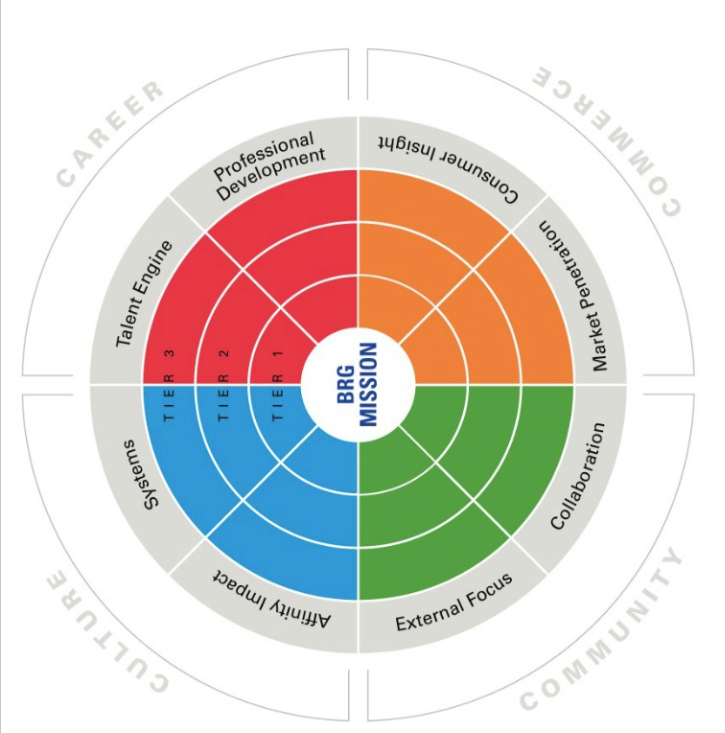
Robert Rodriguez
This article is an excerpt from Diversity Best Practices’ upcoming publication, the ERG Leadership Handbook, your go-to guide whether you plan to introduce ERGs (Employee Resource Groups) into your diversity program for the first time or you wish to enhance and/or expand a mature, successful program. Each chapter offers an in-depth discussion of its respective ERG development phase and is supplemented by related, real-world ERG case studies. Concrete tips, tools and templates are included throughout. Look out for more info on how you can order the book soon!
The 4C Model was first introduced to corporate America in 2006 by Dr. Robert Rodriguez of DRR Advisors LLC. Since then, hundreds of corporations have adopted the 4C Model as the strategic framework for their employee resource groups (ERGs). Companies use the 4C Model to segment ERG initiatives into one of four categories: Career, Community, Culture and Commerce.
The 4C Assessment was created in 2008 to allow companies to measure how well their ERGs were performing in each of the 4C areas. As of 2018, approximately 200 corporations, from a variety of industries, have completed the 4C Assessment including companies such as Allstate, Avon, Best Buy, Comcast/NBCUniversal, Dow Chemical, FiatChrysler, MetLife, Northwestern Mutual, SC Johnson, State Street and the TJX Companies to name a few.
On average, each company assesses about 8 ERGs and about 350 employees participate in each company survey. All of these survey responses feed into the 4C Assessment normative database that now has over 75,000 individual data-points.
All of this data is mined for analytic purposes and provides insights into the current state of ERGs in corporate America. Here are 7 Data Mining insights provided by the 4C Assessment normative database.
ERG Leadership Roles Need to Be Highly Desired
If it is difficult to get employees to serve as the chair or president of your ERGs, the data indicates that your ERGs will have a difficult time making a tremendous impact. Our data shows a very high correlation between top-tier ERGs and those who score high on the survey question “Our ERG Leadership Roles are Highly Desired and Coveted.” This means companies need to design ERG leader roles that are meaningful and provide many benefits to the leader. If you need to convince or beg people to take an ERG leader role, our analytics indicate your ERGs will under-perform.
Top Grade Your ERG Leaders
Our analysis shows that ERGs tend to only be as strong as their ERG leaders. This is why we are seeing more and more corporations move towards appointing the ERG leaders as opposed to allowing ERGs to elect their own leaders. An appointment process improves the probability that a strong performer will hold the ERG leader role. Top tier ERGs tend to score very high on the survey question, “Our ERG has Strong Performers in the Top ERG Leadership Role.” Additionally, the data indicates that when companies appoint their ERG leaders, the ERG leader roles become more desirable and coveted.
ERGs are an Under-Utilized Asset
Companies often blame the ERGs for not making a big enough impact on the obtainment of business goals. Some even change the names of the ERGs to Business Resource Groups (BRGs) in the hopes that this alone will help make sure that the ERGs are not seen as only social groups. However, the data indicates that ERGs want to support business goals and they are often proactive in reaching out to business units to find ways to help. The real reason that ERGs don’t make a business impact is that the business units don’t know how to best utilize the groups. The result is that ERGs sit idly by and are under-utilized by the company to provide business value. The ERGs that seem to be pulled into business meetings and are asked to support business goals the most often appear to be the Hispanic ERGs. This is likely due to the fast growth of the Hispanic consumer market and companies realizing their Hispanic ERG members can provide valuable insights.
Professional Development Across the Career Continuum is Lacking
ERGs tend to score well in the area of professional development by employees who are individual contributors, specialists and entry-level managers. However, when employees who take the assessment indicate they are at the sr. manager, director level or above, their survey scores on professional development questions are extremely low. This indicates that the professional development needs for more senior level employees are not addressed by ERGs. When this happens, ERGs no longer become relevant to senior level employees and they tend to leave the group or not join in the first place. What this means is that ERGs need to periodically review their professional development offerings to see if they address topics that are helpful to more senior level employees and not focus on meeting professional development needs of more junior employees. The one ERG that appears to have figured this out are Women’s ERGs as their professional development scores remain high from employees at all career levels including from their more senior level members.
ERGs are Not Benchmarking Adequately
There are several questions on the assessment that focus on the level of benchmarking ERGs do with ERGs at other companies. The response is surprisingly low with many ERGs indicating they do no benchmarking with external ERGs. Benchmarking helps ERGs learn best practices, find ways to collaborate and gain insights into potential solutions to common ERG challenges. Companies should encourage their ERGs to reach out and try to connect with ERG leaders at other corporations and to try to establish regular meetings. For example, approximately 40 companies in the greater Chicagoland area have their Latino ERG leaders meet on a quarterly basis. The group, called the Consortium of Latino Employee Organizations (CLEO), rotates who will host the quarterly meeting and each time they meet they focus on particular topic such as raising member engagement or establishing metrics that matter. The CLEO group in Chicago has met every quarter for the past 10 years and now a CLEO group in the San Francisco/Silicon Valley area has launched to promote similar benchmarking.
Not All Business Units Value ERGs
When completing a 4C Assessment, companies get to select up to 5 cuts of the data for their results. Common data cuts include by ERG, location, job level and by ERG role. A data cut that has been adopted by an increasing number of companies is to have employees indicate their business unit. The result has provided very valuable insights to companies. By reviewing the 4C results by business unit, companies can better determine which parts of the organization are more supportive of their ERG efforts than others. Recently, one client found that the employees that were in one particular business unit scored very low on the assessment. Upon further follow-up, the company was able to determine that the majority of managers in this particular business unit felt that ERGs were not helpful, a waste of time and they did not support their employees’ involvement in ERGs. With this insight, diversity and HR leaders were able to hold a series of meetings with the leaders in this business unit to clarify the importance of ERGs. Without this insight from the 4C Assessment, diversity leaders would not have known about the lack of support in this particular ERG. In general, employees in sales and in call centers tend to receive the least amount of support from their managers regarding ERG involvement. Employees in HR and marketing tend to receive the most ERG support.
Career and Commerce are Key
The 4C Model does not place more importance on any one of the 4C areas (Career, Community, Culture and Commerce) over the other. However, an analysis of the results in the 4C Assessment database does provide two interesting points for consideration. First, when companies score high on their Career related questions, it is more likely that they will be able to maintain or improve the scores in the other three areas. It’s as if the Career portion of the 4C Model is a driver for the other three areas. Second, when ERGs score low in the Commerce related questions, they have difficulty attracting top talent to their ERGs and they ERGs are not given the credibility and respect they deserve. Without strong Commerce scores, ERGs tend to be labeled as the “food, flag and fun folks” by others thus making it difficult to attract top talent or make a business impact.
The 4C Assessment and its normative database contains plenty of data for analysis resulting in ERG insights. The insights shared here are just some of the many interesting findings that can help companies make smarter business decisions related to their ERGs. ERG data mining is critical in the analytical discovery process and is key to predicting future ERG outcomes, uncovering improvement opportunities, increasing member engagement and elevating ERG impact to the business and its members. Forward-thinking organizations that have completed the 4C Assessment are leveraging the insights as a competitive differentiator to solve today’s toughest ERG challenges.
Dr. Robert Rodriguez is the creator of the 4C Model and the 4C ERG Assessment instrument. He is the president of DRR Advisors (www.drradvisors.com), a company that specializes in elevating ERG performance and impact.

